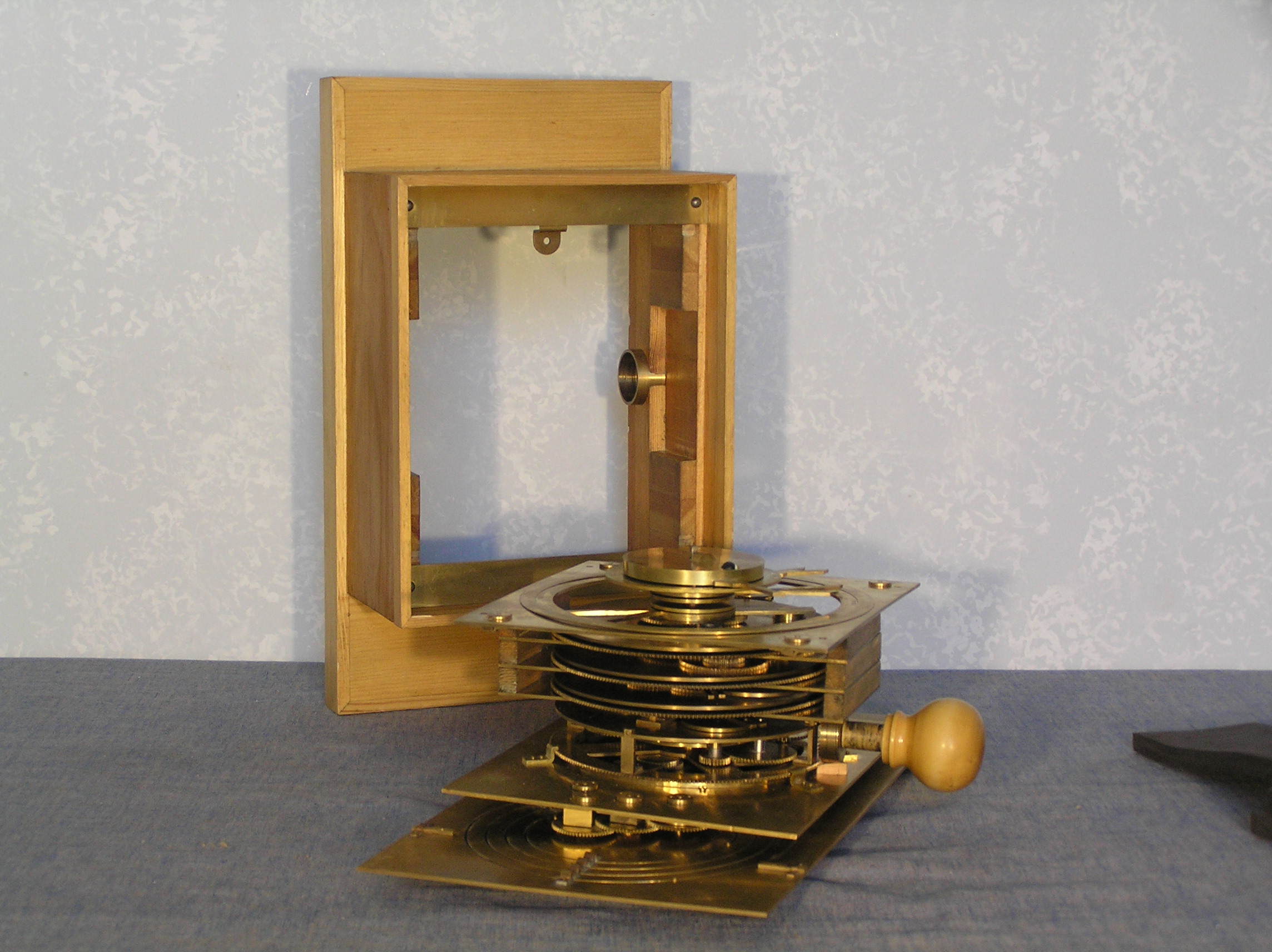|
The Antikythera Mechanism: model
by M.T. Wright, London
The original fragmentary
Hellenistic artefact, recovered from a shipwreck dateable to
about 70 B.C. and probably made some decades earlier, is the
world’s oldest elaborate astronomical instrument, intended for
computation or demonstration. This reconstruction is based on
Wright’s examination of the original (Wright, 2007), but
incorporates the results of further research by others (Freeth
et al., 2006, 2008).
The inner ring of the front dial
represents the Zodiac, divided into 360 degrees and with the
Zodiacal constellations named. Small letters correspond to a
list of annual astronomical events which survives only in part
on a detached plate and cannot be restored. The outer ring
represents a year of 365 days: twelve named months of 30 days
and five extra days. In this, the Egyptian calendar, the dates
of the solstices and equinox were reckoned to change by one day
every four years, corresponding to a year-length of 365¼ days;
so the calendar ring is moveable.
Hands show the date and the places of the Moon and the Sun; and
a small rotating ball within the Moon hand, half black and half
white, displays the phase of the Moon. This much is certain. The
date hand shows the place of the mean Sun, but since the motion
of the Moon hand was modified by a single anomaly, as in the
lunar theory of Hipparchus, probably there was a separate Sun
hand with a similarly modified motion, as seen here.
Epicyclic mechanism, mostly lost, realized a single-anomaly
theory of the place of at least one planet. The model
illustrates a conjectural restoration, with hands for the five
planets then known, all worked in the same way (Wright, 2002).
|


|
On the back two spiral displays, both divided
into long sequences of synodic months, offer
supplementary information. Sliding indicators on the
hands, guided by tongues running in spiral slots,
show which turn of each scale must be read.
The upper display represents the Metonic
calendrical period; 235 named months, taken to equal
19 years, are laid out in five turns so as to show
which months should have 29 days instead of 30, and
which years should have 13 months instead of 12. A
subsidiary dial to the right shows a four-year cycle
of several Panhellenic games. A second subsidiary
dial to the left, restored conjecturally, displays
the 76-year Callippic period which is cited on a
detached fragment.
The lower spiral represents the Saros period of
223 synodic months, after which the pattern of
eclipse-possibilities is repeated. Possible lunar
and solar eclipses are identified, together with the
expected times of day. (The sequence cannot be fully
restored.) The whole pattern falls about one-third
of a day later in each successive cycle, and the
subsidiary dial indicates corrections in hours to be
added to the eclipse-times in each cycle.
Separate bronze plates (not shown) covered both
dials. Surviving fragments suggest that they were
extensively inscribed with information about the
displays and perhaps notes on working the
instrument. |

--------------------
The Florence Catalog pages on
The
Mechanism.
Bibliography :
M.T. Wright, “In the Steps of the Master Mechanic”, Proc.
Conf. Ancient Greece and the Modern World, University of Patras
2003, pp. 86 – 97.
T. Freeth et al., “Decoding the ancient Greek astronomical
calculator known as the Antikythera Mechanism”, Nature, 444 (30
November 2006), pp. 587 – 591.
M.T. Wright, “The Antikythera Mechanism reconsidered”
Interdisciplinary Science Reviews, 2007, vol. 32, no. 1, pp. 27
– 43.
T. Freeth et al., “Calendars with Olympiad display and
eclipse prediction on the Antikythera Mechanism”, Nature, 454
(31 July 2008), pp. 614 – 617.
-----------------
Pedal actuated Lathe of the type
used by M.T. Wright for his works.
-----------------

Quickly made cradle for X-ray Axial Tomography used by M. T.
Wright and late A. Broomley to obtain plenty of
X-ray pictures of the Antikythera Mechanism fragments at the
Athens Museum. |



